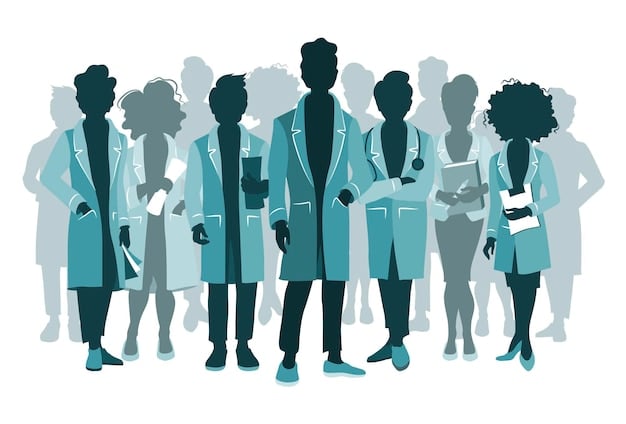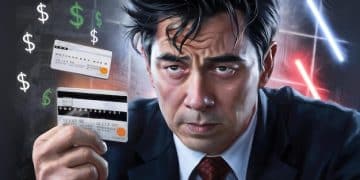Federal Student Loan Forgiveness: Latest Changes Unpacked

Navigating the ever-evolving landscape of federal student loan forgiveness programs requires understanding recent policy shifts and their implications to effectively manage educational debt and explore available relief options for borrowers.
The intricate world of federal student loan forgiveness programs is constantly shifting, leaving many borrowers feeling overwhelmed and uncertain about their options. Understanding the latest changes is crucial for anyone with student debt, as policies can significantly impact financial futures. This guide aims at decoding the latest changes to federal student loan forgiveness programs: what you need to know now, providing clarity and actionable insights in a complex financial environment.
The Evolving Landscape of Federal Student Loan Forgiveness
The federal student loan landscape has been a dynamic area of policy, especially in recent years. Understanding the foundational programs and how they have been reshaped is essential for any borrower. These changes are not merely administrative tweaks; they represent significant shifts in how borrowers can achieve relief from their educational debts. It’s a journey from initial eligibility to the nuanced requirements that define successful forgiveness.
Historical Context and Recent Shocks
Historically, federal student loan forgiveness has been available through a variety of programs, each with specific criteria. The Public Service Loan Forgiveness (PSLF) program, for example, has been a cornerstone for those in public service, offering relief after a decade of qualifying payments. Other income-driven repayment (IDR) plans also promise forgiveness after 20 or 25 years. However, the operational reality of these programs has often fallen short of borrower expectations, leading to calls for reform and, subsequently, significant policy overhauls. The past few years have seen unprecedented actions, including payment pauses and attempts at broad-based forgiveness, which have both introduced new opportunities and added layers of complexity.
- The COVID-19 pandemic initiated a significant pause on federal student loan payments and interest, fundamentally altering the immediate repayment landscape for millions.
- Proposals for widespread student loan forgiveness, while facing legal challenges, have signaled a growing political will to address the national student debt crisis.
- Administrative actions by the Department of Education have sought to simplify and expand access to existing forgiveness programs, particularly PSLF and IDR plans.
Key Administrative Actions and Their Impact
Recent administrative actions have focused on streamlining processes and correcting past errors that prevented eligible borrowers from receiving forgiveness. These efforts aim to rectify historical misapplications of rules, ensuring that borrowers who have met the spirit of their agreements are not penalized by bureaucratic hurdles. For private loans, no such broad relief has been available, emphasizing the distinct differences between federal and private debt options. This distinction is paramount, as new federal policies rarely extend to privately held loans, making it critical for borrowers to understand their loan types.
The Department of Education’s initiatives have specifically targeted improving the PSLF and IDR programs. This includes reviewing payment counts, addressing forbearance steering, and making it easier for borrowers to consolidate loans without losing credit for past payments. These changes are not automatic for everyone; they often require borrowers to take specific steps, such as consolidating their loans or applying for a specific review, underscoring the need for proactive engagement.
Navigating the Public Service Loan Forgiveness (PSLF) Program Enhancements
The Public Service Loan Forgiveness (PSLF) program has undergone substantial revisions, making it a critical area of focus for many borrowers. These changes are designed to address previous frustrations and expand eligibility, potentially offering a lifeline to thousands who previously felt excluded. Understanding the nuances of these enhancements is key to leveraging the program effectively.
Expanded Eligibility for PSLF
One of the most significant changes to PSLF is the expansion of eligible payment types and employment periods. Historically, strict rules often disqualified borrowers for minor administrative errors or payment mix-ups. The new guidelines aim to be more inclusive, recognizing a broader range of payments and employment scenarios that can count towards the 120 required qualifying payments. This includes periods previously considered ineligible, such as certain forbearance or deferment periods, under temporary waivers.
For instance, payments made under any repayment plan now count towards PSLF, not just income-driven plans, during the limited PSLF Waiver period. This temporary leniency offers a significant opportunity for borrowers who were previously on non-qualifying repayment plans to receive credit for those months. The expansion is a direct response to feedback from borrowers and advocates who highlighted the program’s restrictive nature.
PSLF Waiver and Account Adjustment
The limited PSLF Waiver, which expired on October 31, 2022, allowed many borrowers to count past payments that would have otherwise been ineligible. While the waiver itself is over, its effects continue to be processed, and borrowers who applied before the deadline are still seeing their payment counts adjusted. Furthermore, a one-time account adjustment is being applied to all federal loan borrowers, including those aiming for PSLF, to correct historical inaccuracies in payment tracking and to adjust counts for specific forbearance and deferment periods.
This adjustment is particularly beneficial for borrowers who were placed in long-term forbearance by their servicers. The Department of Education is actively reviewing accounts to automatically grant credit for these periods, potentially bringing many closer to their forgiveness goals. Borrowers do not need to apply for this specific adjustment, but it’s wise to monitor loan accounts to ensure appropriate credit is applied once the review is complete. This initiative represents a significant step towards rectifying past administrative errors and providing the intended relief to public servants.
Steps for Current and Future PSLF Participants
For those currently pursuing PSLF or considering it, there are several crucial steps to take. First, ensure all federal loans are Direct Loans; if not, consolidation may be necessary to maximize eligible payment counts, especially with the ongoing account adjustments. Second, regularly submit the PSLF Employment Certification Form (ECF) to track eligible employment and payments, even if not yet eligible for forgiveness. This helps ensure that employment is properly documented and payments are counted accurately, preventing potential issues down the line.
Finally, stay informed about any new announcements or deadlines from the Department of Education. The landscape of student loan relief is continually changing, and proactive engagement is the best way to ensure maximum benefit from these programs. Consulting with a trusted financial advisor or a non-profit student loan counseling service can also provide personalized guidance on navigating what can often feel like a complex maze.

Understanding Income-Driven Repayment (IDR) Plan Overhauls
Income-Driven Repayment (IDR) plans are designed to make federal student loan payments more manageable by tying them to a borrower’s income and family size. These plans typically offer forgiveness of the remaining balance after 20 or 25 years of qualifying payments. Recent overhauls signify a major redesign, aiming to simplify the system and make it more generous for many borrowers.
SAVE Plan (Saving on a Valuable Education)
The newest and most significant overhaul to IDR plans is the introduction of the SAVE Plan, which is replacing the Revised Pay As You Earn (REPAYE) Plan. The SAVE Plan is touted as the most affordable IDR plan yet, and it offers several key improvements for borrowers. Its primary goal is to reduce monthly payments for many and prevent interest capitalization, which has historically caused loan balances to grow even when borrowers make their payments.
Under the SAVE Plan, calculations for monthly payments are more favorable. It raises the income exemption from 150% to 225% of the federal poverty line, meaning a larger portion of a borrower’s income is protected from payment calculation. Additionally, it significantly reduces the discretionary income percentage used for payment calculations for undergraduate loans. These changes collectively lead to lower monthly payments for the majority of enrollees, making debt more manageable.
Key Enhancements and Benefits of the SAVE Plan
The SAVE Plan introduces several critical enhancements designed to address common criticisms of previous IDR plans. One of the most impactful changes is that interest will not capitalize as long as borrowers make their monthly payments, even if those payments are $0 due to low income. This means that if a borrower’s calculated monthly payment is less than the interest that accrues, the government will cover the difference, preventing the loan balance from growing.
- Increased income protection: More of a borrower’s income is exempt from payment calculations.
- Lower discretionary income percentage: Payments for undergraduate loans are reduced to 5% of discretionary income, down from 10-15% in other IDR plans.
- No interest capitalization: As long as scheduled payments are made, loan balances won’t grow due to unpaid interest.
- Earlier forgiveness for some: Borrowers with original principal balances of $12,000 or less may receive forgiveness after just 10 years of payments.
The One-Time IDR Account Adjustment
Similar to the PSLF account adjustment, the Department of Education is conducting a one-time adjustment of IDR-qualifying payments for all federal loan borrowers. This initiative is critical for rectifying historical issues, such as past forbearance steering or administrative errors that prevented borrowers from accumulating qualifying payments toward IDR forgiveness. This adjustment aims to ensure that borrowers receive credit for every month they were in repayment, or even in certain deferment/forbearance statuses, moving them closer to forgiveness.
This one-time adjustment is automatic for eligible borrowers; no action is required. However, borrowers might need to consolidate commercially held Federal Family Education Loan (FFEL) Program loans, Perkins Loans, or Health Education Assistance Loan (HEAL) Program loans into a Direct Consolidation Loan to benefit from this adjustment. The adjustment is set to significantly increase the number of borrowers eligible for IDR forgiveness by accurately counting past payments.
Understanding the Fresh Start Initiative for Defaulted Loans
The Fresh Start Initiative is a crucial program designed to help millions of borrowers who defaulted on their federal student loans emerge from default and regain access to federal student aid benefits. This initiative represents a significant opportunity for those struggling with the severe consequences of default, offering a path to rehabilitation without the extensive requirements of previous default resolution programs.
Eligibility and Benefits of Fresh Start
The Fresh Start Initiative applies to most federal student loans that were in default prior to the COVID-19 pandemic payment pause. This includes Direct Loans, FFEL Program loans, and Perkins Loans held by the Department of Education. Borrowers with these defaulted loans are automatically eligible for the benefits of Fresh Start, which include the removal of the default status from their credit reports, restoration of eligibility for federal student aid, and access to income-driven repayment plans.
The primary benefit is immediate removal from default. This eliminates the severe consequences of default, such as wage garnishment, tax refund offset, and ineligibility for federal student aid. Instead of going through a lengthy and often difficult loan rehabilitation process, Fresh Start offers a direct pathway to get back on track financially and academically. Importantly, this initiative doesn’t forgive the loan balance, but it wipes the slate clean regarding the default status itself, offering a new beginning.
Steps to Utilize Fresh Start
While the eligibility for Fresh Start is broad and automatic for many aspects, borrowers do need to take a proactive step to maximize its benefits and prevent future default. The key is to contact their loan servicer or the Default Resolution Group to transition their loans out of default into an active repayment status. Once out of default, borrowers can then choose a repayment plan, including the new and potentially more affordable SAVE Plan.
Upon re-entering repayment, it becomes vital for borrowers to select a plan that fits their financial circumstances. Enrolling in an IDR plan, like the SAVE Plan, can significantly reduce monthly payments and help prevent re-default. It’s also an opportunity to confirm updated contact information and ensure that all communications regarding loan status and repayment are received. The window for taking advantage of Fresh Start is typically limited, emphasizing the need for timely action.
The Broader Impact on Borrowers and the Economy
The Fresh Start Initiative has a two-fold impact: it provides individual relief and contributes to broader economic stability. For individual borrowers, the removal of default from credit reports can significantly improve credit scores, opening doors to better housing, car loans, and other financial opportunities previously inaccessible. This restoration of financial health empowers individuals to participate more fully in the economy.
On a larger scale, by helping millions of borrowers resolve their defaulted loans, Fresh Start reduces the overall burden of student loan debt in default, potentially stabilizing the federal student loan portfolio. It also brings more borrowers back into active repayment, contributing to the financial health of the federal loan programs. This holistic approach signals a commitment to supporting borrowers through difficult financial periods and ensuring a fairer, more accessible higher education system.
Future Outlook and Anticipated Policy Changes
The landscape of federal student loan forgiveness is not static; it continues to evolve with changing political priorities and economic conditions. Staying informed about potential future policy changes is just as important as understanding current programs, as these shifts could further impact eligibility, forgiveness timelines, and overall financial obligations for borrowers.
Potential Legislative and Executive Actions
While some of the most significant changes have come through administrative actions, there is always the potential for new legislative measures or further executive actions. Congress could pass new laws that modify existing forgiveness programs, introduce new ones, or even address the rising cost of higher education directly through tuition reform. Executive actions, on the other hand, might focus on further expanding eligibility for current programs or simplifying application processes.
The ongoing debate around the affordability of higher education and the burden of student loan debt continues to fuel discussions about potential policy interventions. This includes discussions around potential for further broad-based debt cancellation, even after past attempts faced legal challenges. Borrowers should monitor policy news from both legislative and executive branches, as changes from either source could have substantial implications for their repayment strategies.
Impact of Ongoing Legal and Political Debates
Federal student loan policies, especially those related to forgiveness, are often subject to intense legal and political scrutiny. Court challenges to executive actions, like those seen with previous forgiveness attempts, can lead to uncertainty and delays. The political climate, particularly leading up to elections, also plays a significant role in shaping the conversation and potential for new policies.
The legal and political arenas can both accelerate and impede changes. Legal challenges can halt or modify implementation, while political shifts can create new opportunities for policy reform or, conversely, lead to a rollback of existing benefits. Borrowers need to be aware that even established programs can face new challenges, underscoring the importance of understanding the current rules while also preparing for potential future adjustments. It’s a continuous balancing act of staying informed and adaptable.
Preparing for Future Changes: Tips for Borrowers
Given the dynamic nature of student loan policy, borrowers should adopt a proactive stance to best prepare for future changes. First, ensure your contact information with your loan servicer is always up to date. This ensures you receive timely notifications about program updates and deadlines. Second, keep meticulous records of all payments, communications with servicers, and any documentation related to forgiveness applications.
Finally, consider consulting financial aid advisors or reputable non-profit organizations specializing in student loans. These experts can provide tailored advice based on your specific situation and interpret complex policy changes. Regularly reviewing your loan details and understanding the terms of your current repayment plan will also put you in a stronger position to adapt to any new benefits or requirements that may emerge. Flexibility and informed decision-making are paramount in this evolving debt landscape.

Essential Resources and Next Steps for Borrowers
Navigating the complexities of federal student loan forgiveness programs requires not only understanding the changes but also knowing where to turn for accurate information and assistance. Borrowers must be proactive in accessing resources and taking specific steps to ensure they benefit from available relief programs.
Official Government Sources and Information
The most reliable information regarding federal student loan forgiveness programs comes directly from the U.S. Department of Education and its official channels. The Federal Student Aid (FSA) website (StudentAid.gov) is the primary resource for program details, eligibility criteria, application forms, and updates. This site provides comprehensive guides, FAQs, and personalized dashboards for borrowers to track their loan status and progress toward forgiveness.
Borrowers should regularly check StudentAid.gov for official announcements, especially concerning deadlines for temporary waivers or one-time adjustments. Relying on unofficial sources can lead to misinformation or missed opportunities. The FSA website also offers direct contact information for loan servicers, which are critical for discussing specific account details. Always prioritize information from these official government entities to ensure accuracy and avoid scams.
Connecting with Loan Servicers and Financial Advisors
Your loan servicer is your primary point of contact for managing your federal student loans. They handle your payments, provide statements, and can assist with enrolling in repayment plans or applying for forgiveness. It’s crucial to maintain open communication with your servicer, update your contact information, and ask questions about any aspect of your loan that you don’t understand.
While loan servicers provide administrative support, independent financial advisors specializing in student loan debt can offer personalized, unbiased advice. These professionals can help you understand the long-term financial implications of different repayment and forgiveness options, develop a comprehensive debt management strategy, and explain how these programs fit into your broader financial picture. They can be particularly valuable for complex situations or when planning for future financial goals.
Actionable Steps for All Borrowers
Regardless of where you are in your repayment journey, there are several actionable steps you should take now. First, log in to your Federal Student Aid account (StudentAid.gov) to review your loan details, check your loan types, and see if you have any commercially held FFEL loans that might benefit from consolidation. Second, ensure your contact information with both FSA and your loan servicer is up to date, to avoid missing critical updates.
Third, explore the available repayment plans, particularly the new SAVE Plan, using the Loan Simulator tool on StudentAid.gov. This tool can help you compare different plans and estimate your monthly payments and potential forgiveness timelines. Finally, if you believe you qualify for PSLF, ensure your employment is certified annually and that you are making progress towards the 120 qualifying payments. Proactive engagement with these steps can significantly improve your chances of successfully leveraging student loan forgiveness programs.
| Key Point | Brief Description |
|---|---|
| 🔄 PSLF Enhancements | Expanded eligibility and one-time account adjustments for public service workers, counting more past payments. |
| 📉 SAVE Plan Introduction | Newest IDR plan replacing REPAYE, offering lower monthly payments and preventing interest capitalization. |
| ✅ Fresh Start Initiative | Allows millions of defaulted borrowers to regain good standing and federal benefits without rehabilitation. |
| 🔮 Future Policy Shifts | Expect ongoing changes from legislative and executive actions; stay informed via official sources. |
Frequently Asked Questions About Student Loan Forgiveness
The SAVE Plan is the newest Income-Driven Repayment (IDR) plan, replacing REPAYE. It offers lower monthly payments by protecting more of a borrower’s income from payment calculations. A key difference is that it prevents loan balances from growing due to unpaid interest, even if your payment is $0. It also offers earlier forgiveness for some borrowers with smaller original loan balances.
The PSLF One-Time Account Adjustment is automatically applied to federal loan borrowers, including those working towards PSLF. It corrects historical inaccuracies in payment tracking and provides credit for certain past forbearance and deferment periods. You don’t need to apply, but ensuring your loans are Direct Loans through consolidation can maximize its benefits. Monitor your StudentAid.gov account for updates on your payment count.
The Fresh Start Initiative offers a pathway for millions of federal student loan borrowers to get out of default. It removes the default status from credit reports, restores eligibility for federal student aid, and grants access to IDR plans. To fully utilize it, borrowers must contact their loan servicer or the Default Resolution Group to transition loans into active repayment, ideally on an IDR plan.
Consolidating federal student loans into a Direct Consolidation Loan can be beneficial for several reasons under current policies. It can make commercially held FFEL or Perkins Loans eligible for the IDR and PSLF one-time account adjustments. Consolidation also allows borrowers to access the new SAVE Plan. It combines multiple loans into one, simplifying repayment, but consolidate carefully to avoid losing credit for past payments if not done by certain deadlines.
The most reliable and up-to-date information on federal student loan forgiveness programs is available directly from the U.S. Department of Education’s official website, StudentAid.gov. This portal provides comprehensive details on all federal programs, tools like the Loan Simulator, and secure access to your personal loan information. Always refer to official government sources to ensure you receive accurate guidance and avoid potential scams.
Conclusion
The landscape of federal student loan forgiveness is in constant flux, marked by significant administrative reforms and new programs designed to offer relief to millions of borrowers. From the expanded eligibility of PSLF and the borrower-friendly features of the new SAVE Plan to the Fresh Start Initiative for defaulted loans, understanding these changes is paramount. Proactive engagement, diligent record-keeping, and consulting official government resources remain the most effective strategies for navigating this complex environment and securing the benefits you may be entitled to. Staying informed ensures that borrowers can make the best decisions for their financial future in an ever-evolving system.





